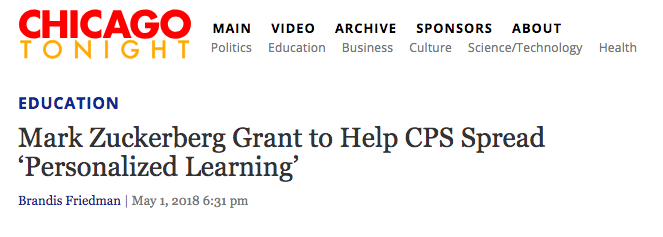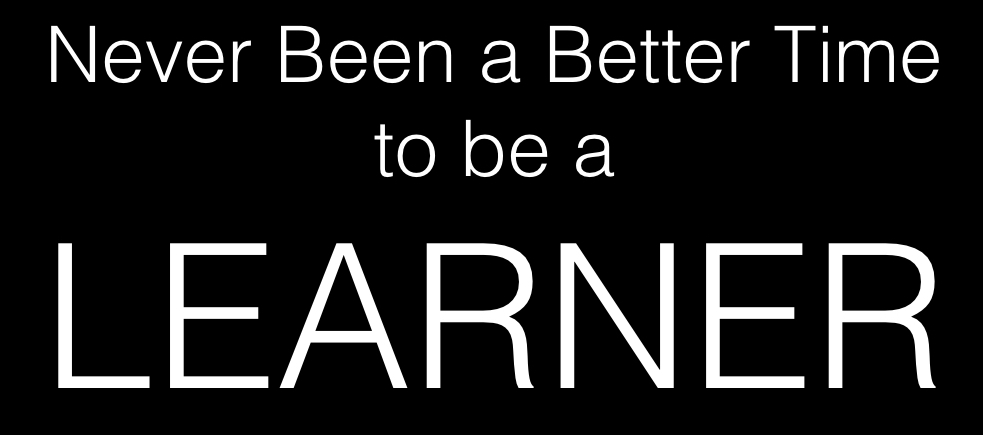Learning from Leaders – What Lines are Others Taking
Following the example of a successful innovator can also get you past the most challenging obstacles and can save your organization time and money.
Course Outcome/Goal
Learners will identify technology innovations and embrace them as opportunities rather than challenges, recognizing that they can proactively use those changes as catalysts to enhance their organizations.
Module Outcome/Goal
After completing this module, you should be able to:
Highlight the opportunities technological innovation spawns.
Develop strategies to proactively use these opportunities to move your institution/districts toward developing active learning environments.
Introduction Video
The Lines That Went Before You
Readings
Refer to the links in the module assignment
Please note: To stay, as current as possible additional cases study examples will be identified and provided shortly before the start of each course.
Want to Innovate? Discussion
Consider the following two TED talks:
In Want to innovate? Become a “now-ist” Joi Ito the head of the MIT Media Lab skips the future predictions and instead shares a new approach to creating in the moment: building quickly and improving constantly, without waiting for permission or for proof that you have the right idea.
Joi Ito: Want to innovate? Become a “now-ist”
http://www.youtube.com/watch?v=VsjTVGIw4z8
In Click here– blended learning and the future of education Monique Markoff challenges us to consider that we have had computers and educational technology for a long time—yet we aren’t we at the point where we are using technology effectively to enhance the learning environment? What can we do about this?
Click here– blended learning and the future of education: Monique Markoff at TEDxIthacaCollege
Instructions
Participate in a class discussion, which you begin by addressing the following issues/questions.
What else can we learn from these examples of innovation?
Education is what people do to you and learning is what you do to yourself… need to learn is how to learn. Are you actually practicing this in your learning environment? Why or why not?
Ito challenges us to: “Stop this notion that you need to plan everything, you need to stock everything you need be so prepared and focus and being connected, always learning fully aware and super present. I don’t like the word futurist I think with we should be “Now ists”. If you are not a Now ist, what is holding you back?
Are you flexible? Is your school flexible enough to allow teachers to be innovative and to experiment blended learning or other ways to use technology to enhance learning?
Are you committed to have kids really use technology? Are your colleagues able to commit to use the technology?
Are you able to able to create the necessary learning environment where students are giving the choice, ownership, and voice through authentic projects?
Please remember the list of questions are for your benefit and are intended to help you focus your thinking. We are not asking nor expect you to answer each question in your discussion–rather you should use these questions to help focus on how the insights gained through this discussion will help you to add another component to your innovation plan.
This discussion will be assessed as part of your participation grade.
Learning from Leaders
Assignment Value: 75 points
In this assignment, you will review examples(s) of organizations who have used disruptive innovation as a catalyst to bring change to their organizations and gain insights and ideas on how to develop an innovation plan or proposal and to also implement a innovation initiative or strategy in your organization.
Since 2008, Abilene Christian University (ACU) has been recognized nationally as a visionary leader in campus-wide exploration and 1-to-1 deployment of iPhones, iPod touches and iPads. Notice how ACU has leveraged mobile technology to bring about transformative change in this Southwest Texas university campus.
The Maine Learning Technology Initiative (MTLI) is one of the longest running best documented 1 to 1 initiatives running in North America. The 10 years of experience with the MTLI provides perspective that we can all learn from.
Instructions
Step 1
As a starting point in your review, consider the significance of what ACU refers to as “Video Vision Casting.” One could argue that the spark that started the process at ACU is the Connected Movie produced in 2007, even before Apple had announced the 3G iPhone. Unfortunately, the video is longer then it could be by today’s Youtube standards so overlook the length and look to the vision that the video creates.
Review the following videos that explain how ACU leveraged the disruptive power of the iPhone and iPad as a catalyst for the change in learning on their campus:
ACU Connected Part 1
ACU Connected Part 2
Review the following ACU Mobile Learning Reports:
2008-09 Mobile Learning Report – https://luonline.blackboard.com/bbcswebdav/pid-1722951-dt-content-rid-21194482_1/xid-21194482_1
2009-10 Mobile Learning Report – https://luonline.blackboard.com/bbcswebdav/pid-1722951-dt-content-rid-21194485_1/xid-21194485_1
2010-11 Mobile Learning Report – https://luonline.blackboard.com/bbcswebdav/pid-1722951-dt-content-rid-21194486_1/xid-21194486_1
AND
If you are considering a 1 to 1 initiative review the MTLI site and pay particular attention to:
About the MTLI – explains the how and why of the program – http://maine.gov/mlti/about/index.shtml
Research & Evaluation Reports – the published results of what worked, what didn’t and why. – http://maine.gov/mlti/resources/research.shtml
MTLI Manual – provides all the details of how the program works. – http://maine.gov/mlti/resources/manuals.shtml
If you are considering a 1 to 1 iPad initiative review the:
Franklin Academy High School Initiative Wiki – http://ipadfa.wikispaces.com/home
If you are considering a blended learning initiative review:
Blending Learning: The Evolution of Online and Face-to-Face Education from 2008-2015 – http://files.eric.ed.gov/fulltext/ED560788.pdf
Blended Learning Implementation Guide: Version 2.0 – http://digitallearningnow.com/site/uploads/2013/10/BLIG-2.0-Final-Paper.pdf
Implementation of Blended Learning at the School Level: A Case Study of the iLearnNYC Lab Schools – http://www.inacol.org/wp-content/uploads/2015/02/a-roadmap-for-implementation.pdf
Blended Learning in DC Public Schools: How One District is Reinventing its Classrooms – https://www.aei.org/wp-content/uploads/2014/01/-blended-learning-in-dc-public-schools_084713921628.pdf
Regardless of your interest in mobile learning, 1 to 1, blended learning, or other technology-focused initiative it is always a good idea to keep the right perspective that it isn’t just about the technology it is about the learning. Alan November does a wonderful job reminding us of this in his article:
Why Schools Must Move Beyond One to One Computing – http://novemberlearning.com/educational-resources-for-educators/teaching-and-learning-articles/why-schools-must-move-beyond-one-to-one-computing/
Similarly, AJ Juliani talks about starting with learning beliefs and learning principles even before talking about technology in his post:
Why We Went Multi-Device, Multi-Platform for Our 1:1 Initiative – http://ajjuliani.com/why-we-went-multi-device-multi-platform-for-our-11-initiative/
These case studies listed above are just a few of many examples of how other organizations have implemented technology to enhance learning. Feel free to use other examples in your planning process.
Step 2
From your review of the sites and case studies in Step 1 and from using the ideas gleaned from your literature review, develop an implementation outline for your innovation plan. At this point in your studies, we do not expect you to have fully detailed and complete report or implementation plan. You do have enough information to develop an implementation outline that provides significant details for the first year of your plan and then a more general or broad overview of the following months or year(s). You will be revisiting and revising this implementation outline in EDLD 5304 and again in other courses in the DLL program.
While the format of the implementation outline is up to you keep in mind that you will be posting this plan to your ePortflio for peer review so this plan MUST be submitted as a link from your ePortfolio. Also, keep in mind that the most important aspect of implementation outline is to identify who your audience will be and why and how they will use the material.
Step 3
Add your outline to your blog site for peer review.
Visit at least three other classmates sites and review their outlines.
Peer Review Process
If you are the first person to visit a classmates site preface your review with the heading “Peer Review 1”, if you are the second, preface your review with the heading “Peer Review 2” and so on. Everyone must follow this heading process so that we can ensure that all outlines get reviewed.
Each outline should be reviewed by at least three different classmates, so if you come on a site that already has three reviews move onto another site and offer your feedback. Feel free to visit all your classmates sites and offer comments and to get ideas for your own outlines.
Your review should take the form of encouragement, questions, suggestions, recommendations and other forms of positive feedback. If you notice issues with an outline ask questions rather than give criticism. All reviews must be completed by midnight on the Wednesday of the following week.
Step 4
Revise your implementation outline based on the comments from your peers.
Include links to your innovation plan and your literature review so that we can see how these components of your change strategy fit together.
Submit the completed implementation outline by 11:59 PM CST on Sunday of the fourth week of the course.
Submission Details:
This assignment MUST be submitted as a link from your ePortfolio so include the assignment URL in the provided document template: Assignment3-EDLD5305-Submission.docx Click for more options
Download the document template,
Post the URL into the space at the top of the document template,
Add your name to the document,
Rename the file with your name and assignment identifier
Upload the file to Blackboard by or before the deadline.
If your assignment does take the form of a Word or Pages document then you can simply paste the content into the document template and complete the assignment submission as outlined above.
The School of Education is using this submission process in its online courses for two reasons:
We wish to provide you an offline copy of the assignment instructions that you can refer to.
We want to ensure there is a consistent and permanent record of assignment submissions that can efficiently be converted to hard copy.
Formats:
While the format of the implementation outline is up to you keep in mind that you will be posting this plan to your ePortflio for peer review so this plan MUST be submitted as a link from your ePortfolio..
Use the APA format to cite your sources.
Use the assignment name, your last name and first initial (assignment name + last name + first initial) to label your assignment submission.
Add to ePortfolio:
Since this assignment is part of the course outcome of identifying technology innovations, embracing them as opportunities rather than challenges, and recognizing that they can proactively be used as catalysts to enhance your learning environment and organization you will also need to add this to your ePortfolio. In the final module you will be required to consolidate all the course assignments into a cohesive section on your ePortfolio, so we recommend that you add this to your ePortfolio as you go along rather than wait until the end.
EDLD 5305 Innovation Plan
EDLD 5305 Module 1
EDLD 5305 Module 2
EDLD 5305 Module 3
EDLD 5305 Module 4
EDLD 5305 Module 5

































